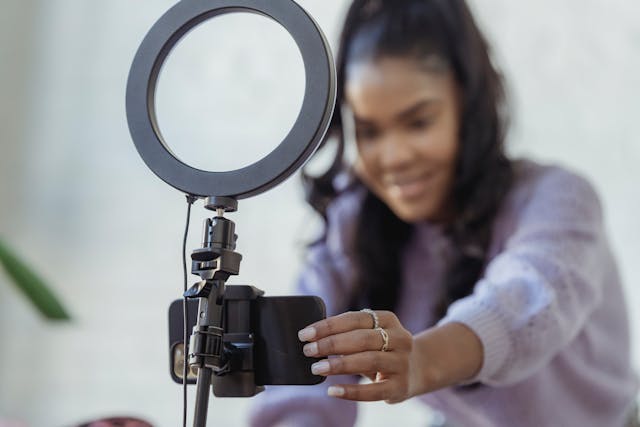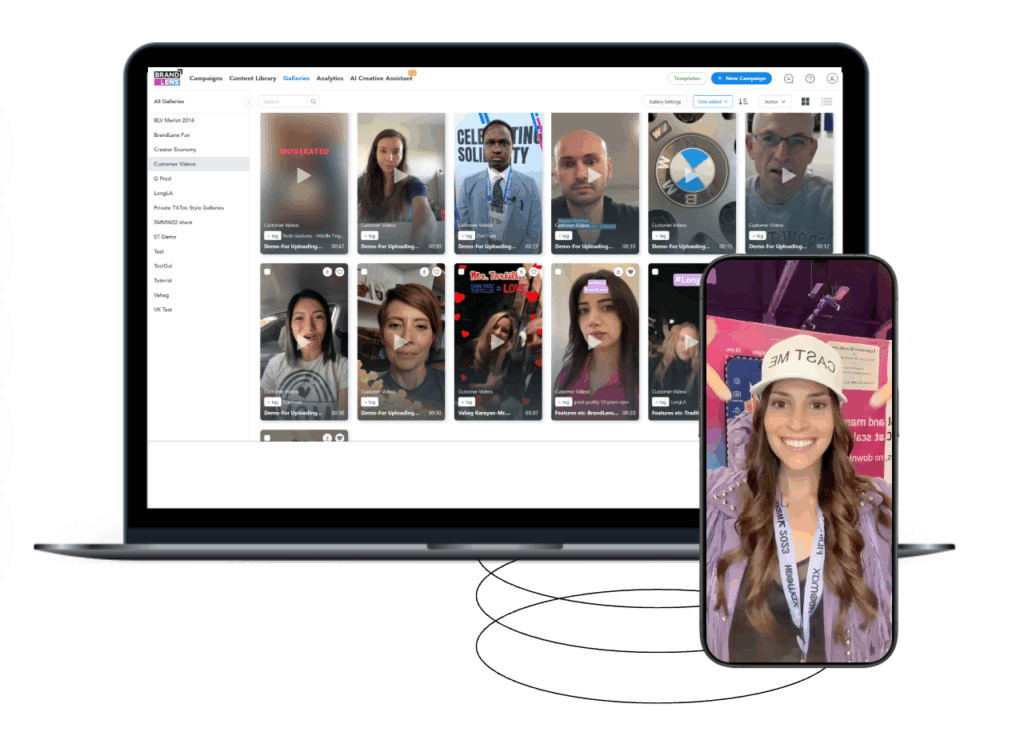Polished video isn’t dead, but it’s no longer the default. It lost its spot as the default tactic, and certainly isn’t the be-all and end-all for every branding goal. What if embracing content with a few, maybe even charming, imperfections could actually make your marketing more effective?
In a world where your audience scrolls past hundreds of clips a day, “perfect” often reads as “pretend.” What wins attention now is something more electric: the feeling that what you’re seeing is real, unfiltered, and human. That’s exactly why lo-fi video content marketing has moved from “experimental” to “essential.”
The Shift Toward Unfiltered Content
Social media, user-generated content (UGC), and creator culture have changed the rules. Viewers reward content that looks like it belongs in their feed, not in a studio. The rise of lo-fi is about relatability, not laziness; it’s about being strategic with imperfection so your brand shows up as a person, not just a logo.
This article unpacks why lo-fi video belongs in every modern brand’s video strategy, where it performs best, and how to do it right without sacrificing brand equity.
For a deeper dive into why brands are embracing unpolished, real video content, read our blog on why brands are embracing unpolished, real video content.
What Is Lo-Fi Video Content?
Lo-fi is not “low effort.” Its content intentionally minimizes production polish to maximize authenticity. Think: natural lighting, handheld framing, ambient sound, real environments. It’s authentic video storytelling by design.
Core Characteristics
- Shot on phones or compact cameras, quickly, where the story actually happens.
- Lightly edited, jump cuts, captions, native app text, on-screen Q&A.
- Real-world backdrops, homes, stores, factory floors, customer sites, or events.
- Conversational delivery, first-person narration, or candid dialogue.
- Sincere imperfection, micro-stumbles, and pauses that signal “this is real.”
Importantly, lo-fi isn’t amateur. It’s a strategic choice to feel native to social feeds and accelerate production. It’s the deliberate alternative in real video vs. studio video decisions: when you need speed, trust, and relatability, lo-fi leads. When you need timeless brand films or Connected TV (CTV) spots, studio polish still shines. Smart teams use both.
Examples You Can Deploy This Week
- A customer films an unboxing at home and narrates first impressions.
- An engineer records a 60-second whiteboard explainer between meetings.
- A store associate captures a quick “What’s new this week?” shelf tours.
- A founder films a front-facing phone update after a product drop.
- A team member hosts a candid, unscripted testimonial with a client over coffee.
Want inspiration you can model? See these examples of successful lo-fi UGC campaigns.
Why Lo-Fi Works Better Than You Think

Why does this approach to video marketing work so well? Three words: relatability, trust, and engagement.
- Relatability: People connect with people, not composites. Lo-fi looks like the content we exchange with friends, so it earns a second look. That’s the heart of relatable content marketing.
- Trust: Audiences are skeptical of perfection. “Unfiltered” signals honesty: no over-lighting, no post-production gloss, just the story. Major trust research shows that “peer voices” and direct dialogue play an outsized role in credibility; translating that into video means empowering customers, employees, and creators to speak plainly on camera.
- Native Engagement: On social platforms, lo-fi often beats brand-film polish because it feels like it belongs there. Even TikTok’s own trend guidance underscores the point: audiences “favor a less-polished, authentic aesthetic” and “IRL” cues: brands meeting people where they are, with human voices and real scenes.
Performance Signals to Watch
Watch-through rate (WTR), saves, replays, and comment quality (e.g., questions, tips) often lift when you favor authenticity over gloss. Industry analyses echo this: self-recorded, UGC-style creatives have outperformed studio-shot content in head-to-heads, including a study showing lo-fi assets winning the majority of tests across Stories placements.
For the human “why” behind this effect, explore this primer on understanding the psychology behind real content engagement.
Platform Momentum
TikTok continues to set the pace for short-form engagement benchmarks, which reward nimble, creator-like output over long lead times. If your creative engine can ship quick, native, iterative lo-fi, your odds of organic traction go up.
The proof is in the numbers. TikTok’s 2025 trends emphasize ‘not over-edited’ creative and real-world, IRL cues, aligning with broader research showing audiences prefer authentic over polished video; e.g., HubSpot finds 63% of consumers favor authenticity, and lo-fi assets can outperform hi-fi in view and reach tests on some platforms.
In a world with shrinking attention spans, holding onto viewers is a huge win. For the brand-safety angle, see our blog on how UGC and co-creation are shaping brand trust.
Benefits for Brands: Cost, Speed, and Scale
Beyond just engagement, lo-fi video offers some very practical advantages for brands: cost savings, speed of production, and scalability.
- Lower Cost: Lo-fi removes the need for large crews, multi-light setups, and rental studios. That doesn’t mean “no budget,” it means a smarter allocation: creator fees, prompts, and lightweight gear (tripods, clip-on mics, bounce cards). The result: more shots on goal for the same spend, critical as Cost per thousand (CPM) fluctuate.
- Faster Cycles: Turnaround compresses from weeks to days (or hours). Lo-fi lets you respond to comments, piggyback trends, or publish updates while the topic is still hot. That agility improves your “creative velocity,” which is the #1 lever for scaling paid and organic performance.
- More Content, More Surfaces: One lo-fi capture can be edited into multiple cutdowns and formats. That makes it ideal for omnichannel reuse, social, email, landing pages, product detail pages (PDP), help centers, sales decks, and even trade-show screens.
- Proof in Behavior: Data from large video hosts consistently shows that utility-first videos (like how-tos) sustain strong retention even without studio gloss; evidence that clarity plus relevance beat cinematic flourishes in most feed-based contexts.
To control budgets without sacrificing results, read our guide on balancing cost and quality with UGC. And for distributed teams, our tips for producing lo-fi content remotely will help you.
Where to Use Lo-Fi Video in Your Strategy

So, where does lo-fi fit into your overall marketing game plan? Here’s a roadmap:
- Landing Pages (LPs): A 30-60s lo-fi testimonial above the fold can lift conversions by providing “real-world proof” at the moment of consideration. Add context text (“Recorded with [Customer Name], June 2025”) to amplify credibility.
- Product Pages (PDPs): Show the product in the wild: how it fits, connects, installs, or solves. Lo-fi here reduces post-purchase anxiety and returns, while adding “evidence density.”
- Email: A founder-recorded quick update or a support rep walking through a fix-in-30 seconds makes emails feel personal and more likely to be watched.
- Social: This is lo-fi’s natural habitat. Capture “day-in-the-life,” behind-the-scenes, reactions, stitches, duets, and comment replies. Treat the comment section like a creative brief: What are people confused about? What can you demo in 20 seconds?
- Ads: Always A/B test “real video vs. studio video.” In prospecting, lo-fi often wins on thumb-stop and watch-through; in retargeting, a hybrid or higher-fidelity edit sometimes seals the deal. Build both into your testing roadmap.
- Sales Enablement: Field teams can record quick “explainers” for FAQs and embed them in proposals or microsites. Short, lo-fi demos shrink time-to-confidence for buyers.
Want a pipeline of real customer videos without creative chaos? Use BrandLens to guide contributors with on-brand prompts, collect clips in one place, and publish across channels, no chasing files or rights. (P.S. It’s tailor-made for raw video content for brands at scale.)
How to Do Lo-Fi Right: Best Practices
Lo-fi is a performance choice, not an excuse. Here’s how to retain authenticity and quality.
- Start With a Strategy
Define your lo-fi pillars: formats (testimonials, how-tos, reactions), hooks (“Show me how…”, “3 things to know before…”), and success metrics (watch-through, saves, comment rate). Determine where lo-fi leads (social plus email) and where studio polish still matters (brand films, major launches). That blend is your social-first lo-fi strategy.
- Give Prompts, Not Scripts
Performance drops when people sound coached. Provide crisp prompts instead:
- “Tell us your problem in one sentence. Show the product by solving it in two shots.”
- “Share one myth, one mistake, one must-do.”
- “Answer this comment in 30 seconds, then invite a stitch.”
- Prioritize Light and Sound
Yes, it’s lo-fi, but viewers won’t forgive muddy audio. Use a $20 clip-on mic, face a window, and kill background noise. If outside, record in the shade; if inside, kill overheads and bounce daylight with a white wall. These are non-negotiable lo-fi video production tips.
- Design for Mobile First
Frame for vertical. Use on-screen text. Add captions (burned-in or auto-generated). Show the “payoff” in the first three seconds (after the hook). Keep cuts tight; remove dead air.
- Respect Rights & Releases
Get permission to film in locations. Use music legally (native libraries are your friend). Collect usage rights from contributors, especially if you’ll run paid ads. This is essential brand hygiene for brand trust and lo-fi visuals.
- Build a Creation Cadence
Aim for weekly “capture sprints” (30-60 minutes) where team members or micro-creators batch-record 5-10 clips each. Store, tag, and version them so you can test quickly across audiences and formats.
- Test Lo-Fi vs. Hi-Fi by Funnel Stage
- Top of the Funnel (ToFu): Lo-fi hooks, UGC-style demos, creator POVs.
- Middle of the Funnel (MoFu): Lo-fi plus overlays (benefits, FAQs), employee explainers.
- Bottom of the Funnel (BoFu): Elevate polish or tighten edits; feature social proof and offers.
- Measure Like a Scientist
Run structured A/B tests (one variable at a time). Track watch-through, hold at 3s/5s, saves, comments with questions (a high-intent signal), and assisted conversions.
- Systematize Co-Creation
Make it easy for customers, employees, and ambassadors to contribute. Clear prompts plus simple capture flows plus automatic rights collection equals scale without chaos.
- Don’t Over-Edit
As mentioned before, a final reminder from the platforms themselves: viewers gravitate to “not over edited,” IRL aesthetics; let human texture and voice lead.
Guardrails for Brand Safety and Consistency
- Message Clarity: Write the one sentence you want viewers to remember. Everything supports that.
- Visual Guardrails: Yes to natural light and handheld. No to offensive backdrops, unsafe usage, or clutter that distracts from the message.
- Tone: Direct, human, and specific. Avoid exaggeration or promises you can’t back up.
- Compliance Checklist: Rights, disclosures (#ad where applicable), and claims substantiation, especially in regulated categories.
- Feedback Loop: Use a shared sheet to log what was tested (hook, angle, caption), where it ran, and the outcome. Repeat winners; fix or retire losers.
Lo-Fi Isn’t a Compromise; It’s a Superpower
Lo-fi isn’t about lowering standards but raising connections. When you design for authenticity, you unlock faster iteration, richer insights, and measurable performance gains. In the battle of real video vs. studio video, the winner isn’t a format; it’s the brand that knows when to use each, and is bold enough to be real when it matters.
With BrandLens, capturing and deploying raw video content for brands is frictionless. You can prompt contributors, collect clips and releases in one place, and publish to every channel without creative chaos. If you’re ready to turn authenticity into advantage, consider this your green light.
Ready to make lo-fi part of your growth engine? Book a demo and explore how BrandLens enables high-performing lo-fi video content marketing through guided co-creation and swift distribution.







